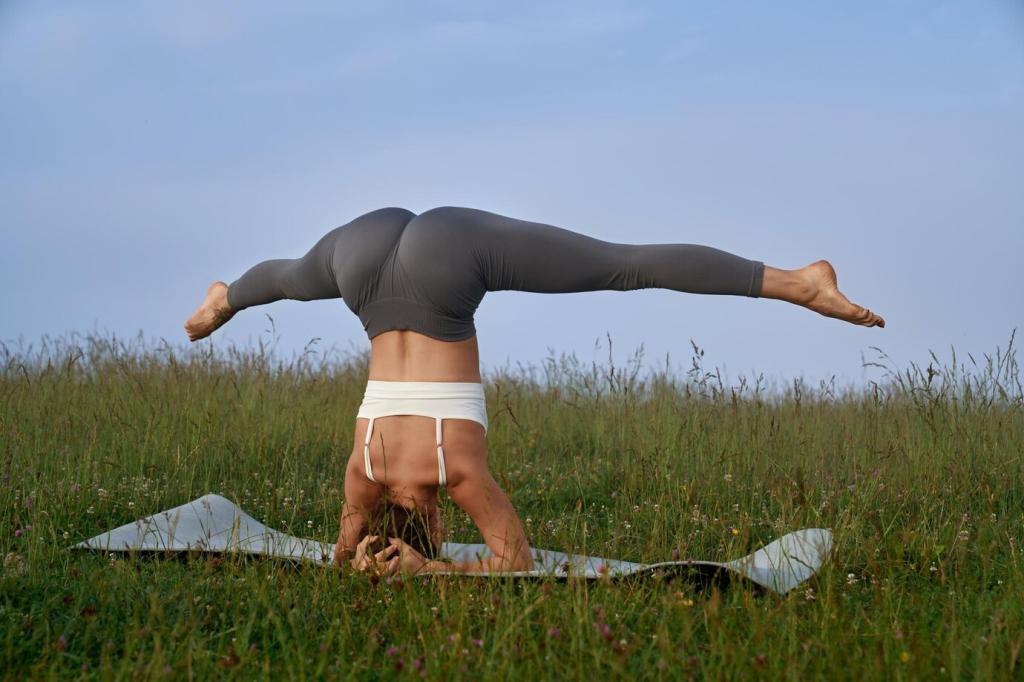Meadow Meditation in Lotus Pose
Today’s chosen theme: Meadow Meditation in Lotus Pose. Settle into the grass, feel the earth lift your spine, and let the open sky widen your breath. Join us as we craft a calm, sun‑warmed practice—and share your own meadow moments in the comments to inspire fellow readers.

Reading Weather, Light, and Wind
Morning dew cools the ankles, afternoon light warms the cheeks, and a gentle breeze steadies attention like a metronome. Scan the sky for shade and shelter, then commit to staying present regardless of shifting clouds. Share your favorite meadow hour and why it suits your practice.
Grounding with Grass, Blanket, and Roots
Sit on a folded blanket to lift the hips above the knees, easing pressure in lotus. Imagine roots spreading from your sit bones, threading through soil and clover. If the ground is uneven, rotate your mat to balance. Comment with your go‑to outdoor setup tips.
Creating a Circle of Safety and Presence
Tell a friend where you’ll be, silence notifications, and set a gentle chime instead of a sharp alarm. Keep water nearby, and glance around to learn the meadow’s sounds. Invite others to join respectfully, or practice solo and report how solitude changes your focus.
Warm up with gentle hip circles, butterfly, and figure‑four stretches. Place the foot well onto the opposite thigh, ankle flexed to protect the knee. If you feel pinching, stop and step back. Share your favorite warmups to help others arrive without forcing or flaring discomfort.
Lotus, Naturally: Aligning the Body with the Field

Breath with Birds and Breeze
Inhale for four as the lark lifts, hold for four as the note hangs, exhale for four as the melody falls, hold for four in the hush. Repeat several rounds. Notice how steady counts steady thoughts. Share whether music of the meadow made counting easier.
Breath with Birds and Breeze
Breathe in for four and out for six or eight, matching breeze that runs longer than it rises. This extended exhale encourages parasympathetic ease. If you feel lightheaded, shorten the count kindly. Tell us how the wind’s tempo shaped your sense of calm and clarity.
Sight: Greens Within Greens
Trace the spectrum—sage, emerald, olive, sun‑tipped blades. Notice fractal patterns repeating in ferns and clover. Let peripheral vision widen, softening eye muscles. When stories push in, return to color and shape. Comment with the hue or pattern that most clearly opened your awareness.
Sound: A Living Choir of Field Notes
Birdsong, insect drone, a distant creek, wind ribboning through stems—name them silently without chasing meaning. Hear the spaces between sounds as active presence. If noise intrudes, label it gently and come back. Which sound, expected or surprising, became your steady companion during practice?
Touch and Temperature: The Honest Ground
Feel weight on sit bones, fabric at the knees, a breeze dusting forearms. Track warm sun on one cheek, cool shade on the other. Adjust if numbness arrives. Share what tactile cue reminded you to relax effort while keeping the pose clear and awake.

A Meadow Story: Emma Finds Her Center
Emma arrived late after a week of back‑to‑back meetings, coffee jitters, and a phone that would not hush. The meadow smelled of thyme. She almost stayed standing. Instead, she sat, crossed one foot onto her thigh, and promised not to rush herself today.
Where Nature Meets Nervous System
Parasympathetic Pathways and the Long Exhale
Gentle, lengthened exhalations can nudge the body toward rest‑and‑digest, slowing heart rate and easing vigilance. Lotus’s upright ease helps diaphragmatic movement. Notice the afterglow—a quieter mind without collapse. Describe how your energy shifted ten minutes after practice compared with just before you began.
Fractals, Soft Fascination, and Attention
Patterns in leaves and grasses invite effortless focus, giving directed attention a chance to recover. This soft fascination reduces mental fatigue without dulling clarity. In lotus, that clarity feels grounded. Which natural pattern—spiral, lattice, ripple—held you gently while you stayed steady and alert?
Sunlight, Posture, and Circadian Ease
Morning light on the eyes can support circadian rhythms; upright sitting helps you breathe more fully without strain. Outdoors, your senses calibrate naturally. If midday is your only option, shade is fine. Comment with the time you practiced and how your sleep felt that night.
